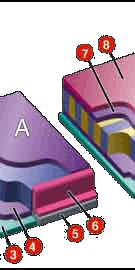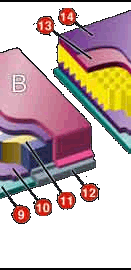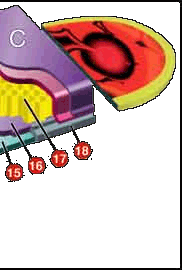

The typical snowboard is designed to face the toughest conditions in any climate, even though it's use is mainly during the winter. In general, a snowboard is composed of several layers to attain a durable, yet light structure. Making the surfaces of a snowboard with a minimal friction coefficient is essential in the snowboard manufacturing industry.
|
http://www.eng.uab.edu/compositesLab/snowhome.html |
Like its various, eye-catching graphic designs, each and
every snowboard has a unique layer structure. The two most basic yet
important layers of a snowboard are the core (4) and the P-Tex/base layer
(10).
The core is usually made of birch wood; it is ideal for its lightweight, rigid, and flexible characteristics. Advances in core technology in recent years allowed the snowboard to become more maneuverable and portable. Hollow aluminum cells with walls in the shape of honeycombs are a breakthrough in snowboard core construction. With this type of core layer the snowboard retains its rigidity, but reduces its weight drastically. Another alternative to the wood core is a foam injected core. Foam can be injected electronically - to any cell size, thus allowing variability in rigidity. |
The P-Tex layer is named after the company that patented the material used for the layer. It is a special type of polyethylene plastic that allows the board to have a minimal friction coefficient when sliding down snow-covered ground, creating a "slippery" feeling. This plastic was designed to absorb wax for conditioning and extended life.
A steel ring (7) serves two purposes: it protects the sides of the snowboard and puts maximum force into the snow for optimum maneuverability.
The graphic layer (2) is a printed layer of fiberglass giving the snowboard an appealing design. There are literally millions of different snowboards with a unique graphic on them, but snowboard consumers may have a custom image printed on their snowboard.
Multiple layers of fiberglass are usually glued on the immediate sides of the core for increased durability. A protective coating lines the top of the snowboard to protect scuffing and minor scratching on the graphics layer




Image courtesy of snowboarding.com
The diagram above shows the different types of layer arrangements in each type of core. Type A shows a foam core, with a large rubber sidewall (6). Type B represents the common wood core layer layout with additional protective layering. Type C shows that the aluminum honeycomb core is similar to the wood core structure, since nearly the same kinds of material are used.
All layers of a snowboard a molded and hot glued together by hand. The tedious process of hand-constructing a snowboard explains why the average snowboard is costly.
Home # Snowboard Design # Snowboard Applications # Bibliography